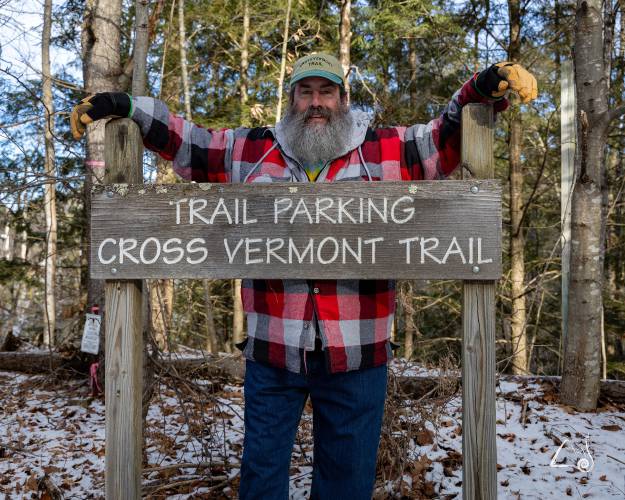Cross Vermont Trail expands into nearby communities with connector to Lamoille Valley Rail Trail
| Published: 04-23-2025 9:00 AM |
Two trails run east-west across Vermont: the Lamoille Valley Rail Trail, which runs from Swanton, Vt., to St. Johnsbury, Vt., entirely on a former rail bed, and the perhaps lesser-known, Cross Vermont Trail, which runs from Burlington through Montpelier to Wells River with just under half of the trail on off-road walking and biking paths.
Michael Thomas of Wells River, a village in Newbury, is a founding member of the Cross Vermont Trail Association and chair of its board. He has been thinking for many years about how the two trails almost parallel each other and wondered, why not connect them?
This year, Thomas and other volunteers plan to publish a map and put up signs along a route that does just that. Running from Danville, Vt., to Wells River, the 19.7-mile BayleyHazen Connector will mainly follow town roads with great views of farmland and forests as well as the White Mountains and Connecticut River, he said.
The selectboards of the towns the connector passes through — Newbury, Ryegate, Vt., Peacham, Vt., Barnet, Vt., and Danville — were all thrilled with the idea, Thomas said. Danville’s chamber of commerce is even supplying funds for the signs in its town. However, an official in one of the towns did note that some already bike those roads.
It’s true, Thomas said, though adding signs will make drivers more aware and the route safer and, in addition, will support more people traveling the formalized route. But there is a broader goal for the BayleyHazen Connector, one the Cross Vermont Trail Association has taken on almost since its inception: not just physically crossing the state, but also reaching out into and serving the communities nearby.
“Eventually, the idea is that we’re all connected — and not just by car,” Thomas said Monday.
Thirty-three years ago, Thomas answered a newspaper ad that marked the very beginnings of the Cross Vermont Trail. “Is anyone interested in creating a trail across Vermont, from East to West?” Thomas paraphrased.
The trail was stitched together using various roads and paths — including parts of the former Montpelier-Wells River railroad — and signs were first placed from end to end in the mid-2000s, Thomas said. Since then, the trail association has focused on steadily moving more and more of its trail off the road — a little over 40 of its 90 miles currently are — as well as growing “sideways” into the community.
Article continues after...
Yesterday's Most Read Articles
For example, the Cross Vermont Trail goes by nine schools, Thomas said, and so far three of those schools have connector trails.
Early on, the association connected its trail with Blue Mountain Union School in Newbury and constructed a five-mile network of trails behind the school. Both are used by classes and community members. Almost every day, Thomas said, there’s at least one car in a nearby lot — a community member using the trails.
Although the Cross Vermont Trail runs the width of the state, it’s mainly intended for people to use the parts near their homes to recreate or commute. It’s not a wilderness trail, Thomas emphasized: it’s a community trail.
“People walk out their door and can ride their bikes or walk their dogs,” he said. “Grandparents can take their grandchildren to walk on terrain they both can handle.”
Over the years, the association has also connected the Cross Vermont Trail with two other schools and their nature trails: Twinfield Union School in Plainfield, Vt., and, most recently, U-32 Middle & High School in Montpelier.
In Montpelier, the association built a 208-foot pedestrian bike bridge across the Winooski River that officially opened in June 2022, getting the route off of high-speed Route 2 and onto a quiet and accessible path — an amazing feat for a non-profit with one full-time employee, Thomas said.
In addition to promoting the BayleyHazen Connector route, the association’s next project will be getting a two-and-a-half-mile section launched into Wells River off Route 302, Thomas said. Right across the Connecticut River from that village, he pointed out, is another cross-state trail: the 83-mile Cross New Hampshire Adventure Trail, which Thomas said was inspired by and modeled after the Cross Vermont Trail.
One other trail connection is in the forefront of Thomas’ mind: in 2023, the Vermont Agency of Transportation gauged municipal support for a potential bicycle corridor that would run approximately 190 miles from the Massachusetts border to the Canadian border along Route 5.
Thomas said he “jumped right out of (his) socks” when he heard the idea.
According to the Agency of Transportation’s study — submitted to the legislature in January 2024 — all 36 towns and regional planning commissions who responded to the survey were supportive of moving forward with a planning study for the bicycle corridor, and almost all said bicycle conditions were poor in their area and that it was important to improve them.
Amy Tatko, spokesperson for the agency, wrote Thursday in an email that the agency has no further role in the potential project at this point, though a bill introduced in the statehouse this session could create a steering committee to guide the development of such a bicycle route.
No matter the long-term outcome of the idea, the possibility got Thomas scheming about a “nice loop” that could further the goal of connecting the Cross Vermont Trail with the community: the majority of Route 5 from Wells River to St. Johnsbury has a wide shoulder and lacks heavy truck traffic, so one could take that to the Lamoille Valley Rail Trail and then loop back on what’s soon-to-be the BayleyHazen Connector.









 A Life: Larry Flint ‘just chose to focus on the positive’
A Life: Larry Flint ‘just chose to focus on the positive’ High school baseball: Windsor rebuilds while Thetford shines
High school baseball: Windsor rebuilds while Thetford shines Local Roundup: Mascoma baseball narrowly loses to Fall Mountain
Local Roundup: Mascoma baseball narrowly loses to Fall Mountain  Local Roundup: Lebanon hosts four-team track and field meet
Local Roundup: Lebanon hosts four-team track and field meet
